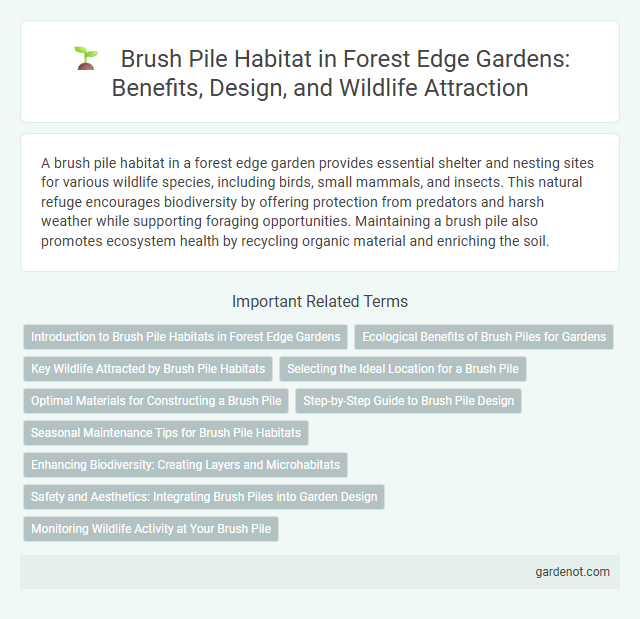A brush pile habitat in a forest edge garden provides essential shelter and nesting sites for various wildlife species, including birds, small mammals, and insects. This natural refuge encourages biodiversity by offering protection from predators and harsh weather while supporting foraging opportunities. Maintaining a brush pile also promotes ecosystem health by recycling organic material and enriching the soil.
Introduction to Brush Pile Habitats in Forest Edge Gardens
Brush pile habitats in forest edge gardens serve as essential refuges for diverse wildlife, fostering biodiversity by providing shelter, nesting sites, and food sources for birds, small mammals, amphibians, and insects. These habitats consist of accumulated sticks, branches, and leaf litter, creating microhabitats with varied moisture and temperature conditions critical for various species' survival and reproduction. Implementing brush piles strategically enhances ecological balance by supporting natural pest control and promoting soil health through organic decomposition processes.
Ecological Benefits of Brush Piles for Gardens
Brush pile habitats enhance forest edge gardens by providing critical shelter and nesting sites for diverse wildlife, including birds, amphibians, and beneficial insects. These structures improve soil health through natural decomposition, enriching garden fertility and promoting native plant growth. By supporting biodiversity and ecological balance, brush piles serve as a natural pest control method, reducing the need for chemical interventions.
Key Wildlife Attracted by Brush Pile Habitats
Brush pile habitats attract key wildlife such as songbirds, amphibians, small mammals, and reptiles by providing essential shelter and nesting sites. These habitats support species like sparrows, salamanders, chipmunks, and garter snakes, contributing to biodiversity in forest edge gardens. The dense, protective structure of brush piles offers food sources and protection from predators, promoting a balanced and thriving ecosystem.
Selecting the Ideal Location for a Brush Pile
Choosing the ideal location for a brush pile in a forest edge garden involves selecting a spot that offers shelter and easy access to food sources for wildlife. Place the brush pile near native shrubs or trees to provide protection from predators while maintaining proximity to sunlit areas that encourage insect activity, which attracts birds and small mammals. Ensure the area has good drainage to prevent moisture buildup, supporting the habitat's longevity and biodiversity.
Optimal Materials for Constructing a Brush Pile
Optimal materials for constructing a brush pile habitat include a variety of hardwood branches, twigs, and small logs to create a dense, insulated structure that supports wildlife such as birds, small mammals, and beneficial insects. Avoid using treated wood or branches from diseased plants to maintain a healthy environment, and incorporate leaf litter and pine needles to enhance cover and moisture retention. Positioning the brush pile near forest edges maximizes access to sunlight and food sources, further increasing its ecological value.
Step-by-Step Guide to Brush Pile Design
Constructing an effective brush pile habitat begins by selecting a dry, shaded area near the forest edge garden to provide shelter for wildlife. Gather a mix of branches, twigs, and logs, arranging the larger pieces as a sturdy base with smaller materials layered on top for nesting and hiding spaces. Ensure the pile reaches at least 3 feet high and wide to maximize habitat value for animals such as birds, amphibians, and small mammals.
Seasonal Maintenance Tips for Brush Pile Habitats
Seasonal maintenance of brush pile habitats in forest edge gardens involves pruning dead branches and removing invasive plant species to promote native biodiversity. Conducting regular cleanups in late winter helps prevent pest infestations and maintains habitat structure for wildlife such as birds, amphibians, and small mammals. Applying mulch around the base stabilizes moisture levels and supports soil health essential for sustaining these ecosystems.
Enhancing Biodiversity: Creating Layers and Microhabitats
Brush pile habitats in forest edge gardens significantly enhance biodiversity by providing layered microhabitats for diverse wildlife, including small mammals, reptiles, and invertebrates. These structures create essential shelter, nesting sites, and foraging opportunities, promoting ecological complexity and species richness. Incorporating varied organic materials in brush piles supports decomposition processes and nutrient cycling, further benefiting the ecosystem's health.
Safety and Aesthetics: Integrating Brush Piles into Garden Design
Brush pile habitats provide essential shelter for wildlife while enhancing garden safety by reducing fire hazards when properly maintained. Integrating brush piles into a forest edge garden design can create naturalistic features that blend seamlessly with surrounding vegetation, promoting biodiversity. Strategic placement near shrubs and trees enhances aesthetics and supports beneficial insect and bird populations, contributing to a balanced ecosystem.
Monitoring Wildlife Activity at Your Brush Pile
Monitoring wildlife activity at your brush pile provides valuable insights into local biodiversity, revealing patterns of use by small mammals, birds, and reptiles. Using motion-activated cameras and regular observational surveys helps document species presence and behavior around the brush pile habitat. Maintaining detailed records over time supports effective management practices to enhance the ecological benefits within your forest edge garden.
Brush pile habitat Infographic

 gardenot.com
gardenot.com